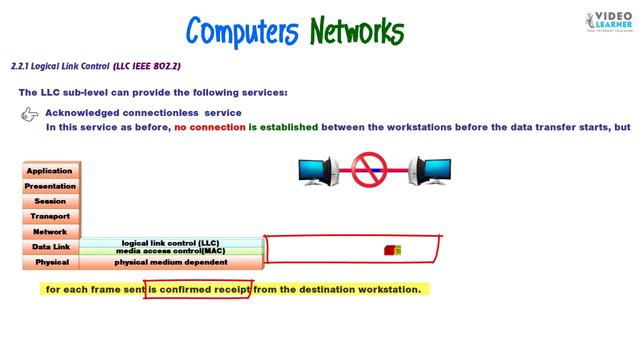Meaning
The user's data link service provides a unified interface for the network layer through the LLC sublayer. Below the LLC sublayer is the MAC (Medium Access Control) sublayer.
This sub-layer is added to the IEEE standard. This sub-layer ensures transmission in different network types by adding an 8-bit destination address service access point and source address service access point to the IP packet . In addition, there is an 8 or 16-bit control field for auxiliary functions like flow control.
Operation method
LLC provides two connectionless and one connection-oriented three operation methods:
Method 1: No response without connection , It allows sending frames:
To a single destination address (point-to-point protocol or single-point transmission)
To multiple destination addresses in the same network (multipoint transmission)
To all addresses in the network (broadcast transmission)

Multipoint and broadcast transmission can reduce network traffic when the same information needs to be sent to the entire network. Single-point transmission cannot guarantee that the order in which frames are received by the receiving end is the same as the order in which they were sent. The sending end cannot even determine whether the receiving end has received the frame.
Method 2: Connection-oriented operation method. By numbering each frame, the receiving end can ensure that they are received in the order in which they were sent, and no frame is lost. Using the sliding window flow control protocol allows the fast sending end to flow to the slow receiving end.
Method 3: No connection with reply. It is limited to point-to-point communication.
Control byte and frame format
The header of LLC contains:
DSAP (Destination Service Access Point) bytes, 8 Bits
SSAP (Source Service Access Point) byte, 8 bits
Control field, 8 or 16 bits
For easy distinction, there are three types of LLC PDU control fields, called U, I, and S frames.
U (Unnumbered) frame, 8-bit control field, especially for connectionless applications
I (Information) frame, 16-bit control and frame number field, used for Connection-oriented application
S (Supervisory) frame, a 16-bit control field, used for management and supervision in the LLC layer.
Among these three formats, only U-frames are widely used. The last two digits of the first byte are used to distinguish these three PDU frame formats.
